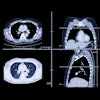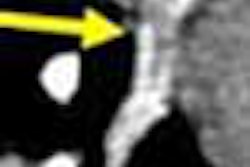New safety features in automobiles are one good reason why multidetector-row CT merits a larger role in foot and ankle trauma imaging, according to radiologists from Sweden. Their rationale for the primary use of MDCT in high-impact foot and ankle trauma can be found in this month's American Journal of Roentgenology.
"Conventional radiography has had and still has an essential and dominant role in the diagnostic evaluation of patients with acute foot and ankle trauma," wrote Drs. Ville Haapamaki, Martti Kiuru, and Seppo Koskinen from Helsinki University Central Hospital in Sweden. "In patients with complex foot and ankle fractures, however, CT is a commonly used imaging technique after radiography. The presence of complex injuries of the ankle and foot seems to be increasing as a result of the increased use of automobile safety devices, such as seat belts and air bags that decrease mortality and protect the trunk, but not necessarily the lower extremities."
The results of a retrospective study of patients with foot and ankle fractures who underwent both imaging tests led the group to recommend MDCT as a primary imaging technique for those with high-energy polytrauma and those with complex foot and ankle fractures (AJR, September 2004, Vol. 183:3, pp. 615-622).
The group examined data from 388 patients (282 males and 106 females, ages 16-89) with acute foot and ankle injures who underwent MDCT and sometimes radiography of the foot at Helsinki's level 1 Töölö Trauma Center between 2001 and 2003. The diagnosis of acute traumatic ankle or foot fracture was based on MDCT, which served as the gold standard.
The patients underwent routine CT imaging of the foot and ankle on a four-slice LightSpeed QX/i scanner (GE Healthcare, Waukesha, WI) at 4 x 1.25-mm collimation, 0.625 interval, and 3.75-mm table speed. Two radiologists experienced in musculoskeletal imaging evaluated both the x-ray images and the standard 2D MDCT coronal and sagittal reformats (slice thickness and reconstruction intervals were both 1 mm).
"In primary radiographs of the ankle (anteroposterior, 20 degree internal oblique [mortise], and lateral views) and the foot (anteroposterior, oblique, and lateral views), when available, were re-evaluated by consensus and were then compared with MDCT images," the authors wrote.
Two radiologists experienced in musculoskeletal imaging retrospectively and by consensus re-evaluated the imaging studies (MDCT and radiography) by fracture location, fracture type, and mechanism of injury.
The results showed that 344/388 patients had one or more fractures in the ankle or foot, for a total of 517 fractures in five anatomic regions: the ankle, calcaneus, talus, midfoot (navicular, cuboid, or cuneiform bones), and forefoot (metatarsal bones). Nine patients had a talocrural fracture or dislocation, and 12 (3%) with luxation of Chopart's joint. A Lisfranc fracture or dislocation was found in 24 (7%) of the patients, two of whom also had a bilateral tarsometatarsal fracture or dislocation.
Radiographs were available in 296/344 (86%) patients with fractures. Among the fractures seen on CT but commonly missed in radiography, three types of occult fractures stood out, including isolated fractures of the posterior and medial malleolus and lateral margin of the distal tibia, for which the sensitivity of primary radiography was 50% to 72% compared to MDCT.
"An occult posterior malleolus fracture can be potentially harmful and can cause complications if not detected and accurately managed, because internal fixation of the posterior malleolus is recommended if the reduced fragment constitutes more than one-fourth to one-third of the tibial articular surface," they commented, adding that the addition of oblique views can increase radiography's sensitivity, but that appropriate positioning of the ankle is difficult for x-ray, and not an issue with CT due to the high quality of reformatted images.
Calcaneal and talar fractures
The most frequently fractured bone was the calcaneus, with the fracture detected in 87% of radiographs compared to MDCT. The degree of depression of the posterior calcaneal facet may often be underestimated in lateral radiographs, the authors explained. Calcaneal fractures typically result from high-energy trauma.
"Nonoperative treatment is best reserved for nondisplaced calcaneal fractures; however, for patients who have displaced intra-articular fracture fragments, nonoperative treatment offers little chance of a return to normal function because a calcaneal malunion will develop," they wrote.
"Especially in cases of complex intra-articular fracture patterns, MDCT with coronal and sagittal multiplanar reconstructions revealed the extent of the fractures, and the position of the dislocated posterior calcaneal facet better than conventional radiography," the group stated.
Meanwhile, x-ray's sensitivity for the rarer talar fractures was 78% compared to MDCT. Isolated fractures of the talar trochlea, for example, were seen in only 34/50 (68%) cases. Talar fractures constitute only about 3% to 6% of foot fractures overall, but accounted for 14% of the fractures in the study, probably due to the patients being brought for treatment at a level 1 trauma center, the authors acknowledged. Among talar fractures associated with a subtalar joint location (11%), primary radiography detected 7/8 intra-articular fractures.
"Subtalar joint dislocations with associated intra-articular fractures involving the subtalar or talonavicular joints can lead to significant subtalar joint arthrosis," they wrote. "The presence of an intra-articular fracture worsens the prognosis, and MDCT with multiplanar reconstructions is a recommended complementary examination to reveal a possible occult intra-articular fracture of the talus if subtalar joint dislocation or subluxation is suspected."
Among 13 luxations of Chopart's joint, five cases were associated with navicular intra-articular fracture. However, no fractures of the corresponding talar joint facet were seen in patients with Chopart's joint luxation, yielding a sensitivity of 67% (8/12) for detection of intra-articular fractures in subtalar or talonavicular dislocations.
Midfoot fractures
X-ray's sensitivity was low in the detection of midfoot fractures as well: 24% to 33% overall compared to MDCT. X-ray detected 5/26 Lisfranc fractures or dislocations (however, radiographs were available in only 21/26). MDCT offered better visualization of the complex fracture anatomy and even of minimal malalignment of the Lisfranc joint without superimposed structures, the authors noted.
"(Midfoot) fractures may be potentially harmful and can cause complications if not detected and accurately managed," the authors wrote. "In the Lisfranc joint, the minimal tarsometatarsal malalignment and fracture lines are difficult to detect on conventional radiographs, and as many as 20% of Lisfranc joint injuries are estimated to be missed on primary anteroposterior and oblique radiographs," and the miss rate was even slightly higher in the study, they added. Moreover, operative treatment is usually called for in the event of a Lisfranc fracture or dislocation, and MDCT, by revealing the extent of fractures and even minimally dislocated joint facets, can aid in presurgical planning.
The three fractures most commonly detected on MDCT but not in radiography were isolated fractures of the posterior and medial malleolus and Tillaux fractures, they wrote.
In all, 99 patients had multiple fractures, including, most commonly, forefoot and midfoot fractures in 21 patients (21%), ankle and calcaneus fractures in 12 (12%), ankle and talus fractures in 11 patients (11%), and talus and calcaneus fractures in 10 patients.
Eleven percent of the patients (n = 54) had negative MDCT. In 7% (n = 29), fractures were suspected on radiographs but proved false on MDCT, when the latter test was ordered to rule out occult fracture.
The cause of injury included falling from a height (48%), simple falls (20%), and traffic accidents (14%). Twenty-six percent of the patients also had injuries in other parts of the body.
As for single versus multislice CT, the latter provides fewer motion artifacts, reduced partial-volume effects, decreased image noise, high-quality multiplanar reconstructions, and isotropic viewing, all of which are helpful in the trauma setting, the authors noted. The average effective radiation dose is 1 mSv, depending, of course, on the size and length of the anatomy being examined.
Patients with multiple injuries from high-impact trauma tend to have multiple fractures, the authors wrote, so the entire foot and ankle should be scanned if MDCT is contemplated. In the present study, MDCT revealed the presence of occult fractures, precisely depicting the anatomy in foot and ankle fractures.
"In conclusion, radiography remains the primary imaging technique in evaluating patients with ankle and foot trauma; however, in patients with multiple injuries from high-energy trauma and in patients with complex fracture patterns, the sensitivity of conventional radiography is only moderate to poor," they wrote. "In these cases, MDCT of the whole ankle and foot is recommended as the primary imaging technique."
By Eric Barnes
AuntMinnie.com staff writer
September 14, 2004
Related Reading
Foot injury may be on rise in football players, August 4, 2004
Total ankle arthroplasty yields mixed results, July 19, 2004
Low-field MR turns in varying results for MSK abnormalities, trauma, December 23, 2003
MRI, US make sense of disorganized scar tissue in PTTL injuries, October 29, 2003
Pediatric ankle exam predicts need for x-rays, November 1, 2002
Turf Wars in Radiology, Part V: Radiologists, orthopedists put best foot forward, October 1, 2002
Copyright © 2004 AuntMinnie.com




















